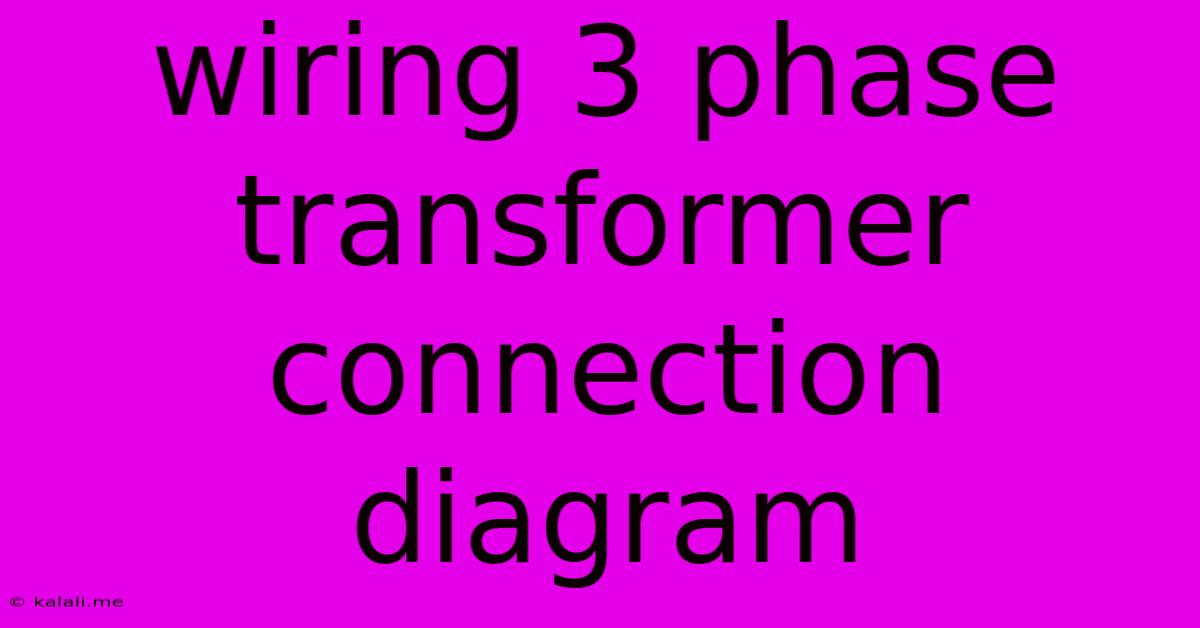Wiring 3 Phase Transformer Connection Diagram
Kalali
Jun 14, 2025 · 3 min read

Table of Contents
Wiring a 3-Phase Transformer: Connection Diagrams Explained
Understanding 3-phase transformer wiring can seem daunting, but with a clear explanation and the right diagrams, it becomes manageable. This article will delve into the various connection types, offering a comprehensive guide to help you navigate the complexities of 3-phase transformer installations. This guide covers the most common configurations and provides visual aids to simplify the process. Remember, safety is paramount; always consult a qualified electrician for any high-voltage work.
Understanding 3-Phase Power
Before diving into connection diagrams, let's briefly review 3-phase power. Three-phase systems deliver power more efficiently than single-phase systems, making them ideal for industrial applications and larger commercial buildings. The three phases are typically represented as A, B, and C, each carrying a voltage offset by 120 degrees. This creates a more stable and powerful power supply. Understanding this phase relationship is crucial for correctly wiring a 3-phase transformer.
Common 3-Phase Transformer Connections
Several connection types exist, each with its own advantages and disadvantages. The most prevalent are:
1. Delta-Delta (Δ-Δ) Connection
-
Description: Both the primary (high-voltage) and secondary (low-voltage) windings are connected in a delta configuration. This configuration offers a high level of fault tolerance, as the system can continue operating even with one winding failing. It's often used in applications where high current is required.
-
Advantages: High fault tolerance, good current carrying capacity.
-
Disadvantages: More complex to wire, may generate higher harmonic currents.
-
Diagram: (Imagine a Delta symbol here representing the connection. A visual diagram would be best suited for this section and subsequent connection diagrams. Since I cannot create images, a detailed description will have to suffice. Each winding of the primary (A, B, C) would connect to the next winding in a triangular fashion, and likewise on the secondary)
2. Wye-Wye (Y-Y) Connection
-
Description: Both the primary and secondary windings are connected in a wye (star) configuration. This configuration is commonly used where a neutral point is needed for single-phase loads. It provides a good balance between voltage and current.
-
Advantages: Neutral point available, simple voltage transformation.
-
Disadvantages: Less fault tolerant than delta-delta.
-
Diagram: (Imagine a Y symbol here representing the connection. Each winding on the primary (A, B, C) connects to a common neutral point, and similarly on the secondary.)
3. Delta-Wye (Δ-Y) Connection
-
Description: The primary winding is connected in delta, and the secondary winding is connected in wye. This configuration provides a voltage step-up or step-down ratio of √3 (approximately 1.732) between the line voltage and phase voltage.
-
Advantages: Provides a different voltage ratio compared to Y-Y and Δ-Δ.
-
Disadvantages: Requires careful voltage balancing.
-
Diagram: (Imagine a Delta symbol connected to a Y symbol. The primary would be connected in Delta, and its output would feed into the Y-configuration on the secondary)
4. Wye-Delta (Y-Δ) Connection
-
Description: The primary winding is connected in wye, and the secondary winding is connected in delta. Similar to Δ-Y, this offers a voltage step-up or step-down ratio of √3.
-
Advantages: Offers a different voltage ratio compared to Y-Y and Δ-Δ.
-
Disadvantages: Requires careful voltage balancing.
-
Diagram: (Imagine a Y symbol connected to a Delta symbol. The primary would be in Y-configuration, its output feeding into the Delta-configuration on the secondary)
Safety Precautions
Working with high-voltage electricity is inherently dangerous. Always:
- Consult a qualified electrician: This is crucial for safety and compliance with electrical codes.
- Disconnect power: Before working on any electrical equipment, always disconnect the power supply.
- Use proper safety equipment: This includes insulated tools, gloves, and eye protection.
- Follow all local electrical codes and regulations.
Conclusion
Wiring a 3-phase transformer involves understanding various connection types and their characteristics. This guide provides a foundation for comprehending the different configurations. Remember to prioritize safety and seek professional help when working with high-voltage systems. Further research into specific transformer models and their wiring instructions is always recommended before undertaking any installation or modification.
Latest Posts
Latest Posts
-
Indiana University Of Pennsylvania Gpa Requirements
Jun 14, 2025
-
Second Most Abundant Element In Earth Crust
Jun 14, 2025
-
Which Of The Following Is A Unit Of Energy
Jun 14, 2025
-
The Cpu Consists Of Which Two Parts
Jun 14, 2025
-
What Seismic Waves Are The Most Destructive
Jun 14, 2025
Related Post
Thank you for visiting our website which covers about Wiring 3 Phase Transformer Connection Diagram . We hope the information provided has been useful to you. Feel free to contact us if you have any questions or need further assistance. See you next time and don't miss to bookmark.